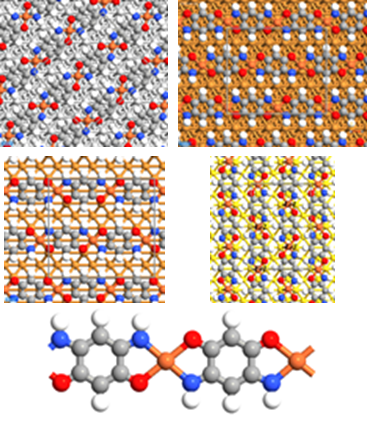Soutenance de thèse de Hassan Denawi - 10/10/2019 - Electronic and Magnetic Properties of Polymer Chains
M. Hassan DENAWI
Electronic and Magnetic Properties of Polymer Chains Exploiting the Reactivity of Zwitterionic Quinone with Transition Metal Atoms
Jeudi 10/10/2019 à 14h00 - salle 7 - Campus de Saint Jérôme. La salle se situe au niveau du TICE / CIPE du bâtiment administratif.
Composition du jury:
|
Andrés ARNAU |
Professeur Université San Sébastian, Espagne |
Rapporteur |
|
Cyrille BARRETEAU |
Chercheur CEA, France |
Rapporteur |
|
Marie-Laure BOCQUET |
Directrice de Recherche au C.N.R.S, France |
Examinatrice |
|
Mathieu ABEL |
Professeur AMU, France |
Examinateur |
|
Abdelkader BOUKORTT |
Professeur Université de Mostaganem, Algérie |
Examinateur |
|
Roland HAYN |
Professeur AMU, France |
Directeur de thèse |
Abstract:
Using the VASP code (Vienna Ab initio Simulation Package) several first principle calculations have been performed to study metal-organic monolayers as free-standing layers and on metallic substrates. The first principles calculations are based on spin polarized density functional theory (DFT) with the spin resolved Generalized Gradient Approximation (SGGA) for the exchange and correlation potential and the Projector Augmented Wave (PAW) pseudo potentials. Due to the well-known problems of standard DFT in describing strongly correlated systems, we use the spin polarized Gradient Approximation with Hubbard term U (SGGA+U) with explicit treatment of the strong electron correlation in the incompletely filled d-shell of the transition metal ions. We study polymers of transition metals (TM) with zwitterionic quinone (ZQ) molecules as one dimensional (1D) chains, two-dimensional (2D) arrangements, or adsorbed on metallic substrates. From the ab-initio calculations we predict the Fe-ZQ zwitterionic quinoidal polymer chains to be one-dimensional spin cross-over compounds. The calculations determine the atomic positions, the magnetic couplings and the electronic structure. We investigate the electronic and magnetic structure of a recently synthesized two-dimensional (2D) arrangement of polymer chains based on Fe atoms and zwitterionic quinone on different metallic substrates (Ag(111), Au(110), Cu(110) and Cu(111)). The adsorption of the Fe atoms and zwitterionic quinone on the surfaces was studied via SGGA+U and the free-standing isolated polymer chain, the 2D arrangement and the adsorbed polymers have been calculated. Furthermore, all the series of 3d TM-ZQ chains has been studied, as well as many 4d and 5d TM. Promising properties show also alternating chains of FeV-ZQ. ZQ.

